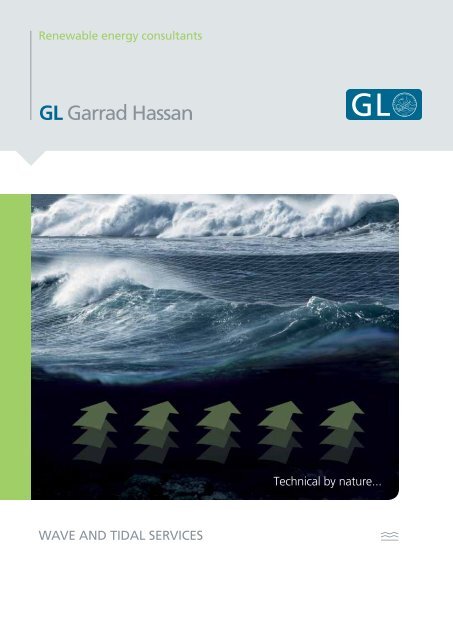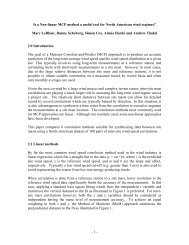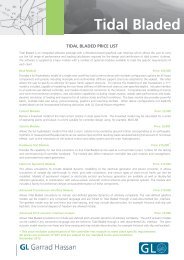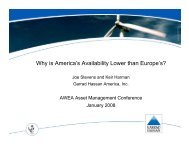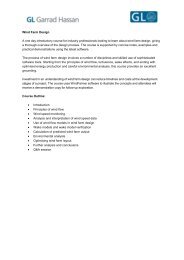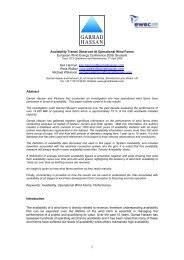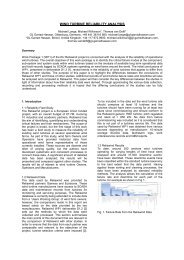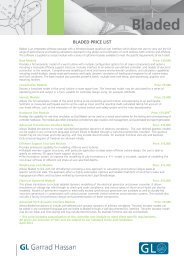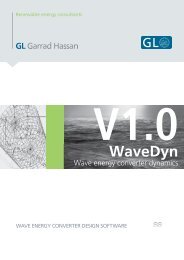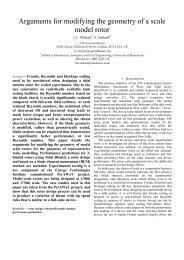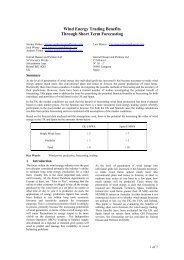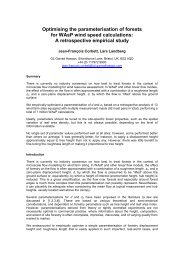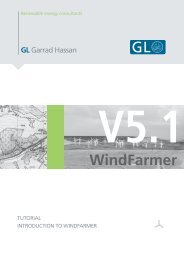Wave and tidal ServiceS - GL Garrad Hassan
Wave and tidal ServiceS - GL Garrad Hassan
Wave and tidal ServiceS - GL Garrad Hassan
You also want an ePaper? Increase the reach of your titles
YUMPU automatically turns print PDFs into web optimized ePapers that Google loves.
Renewable energy consultantsTechnical by nature...<strong>Wave</strong> <strong>and</strong> <strong>tidal</strong> SErvices
About the Marine Renewables GroupLeading a team of dedicatedwave <strong>and</strong> <strong>tidal</strong> experts<strong>Wave</strong> energyJoao CruzHead of <strong>Wave</strong> Energy Group,<strong>GL</strong> <strong>Garrad</strong> <strong>Hassan</strong>PhD, Dip.-Ing.Prior to joining <strong>GL</strong> <strong>Garrad</strong> <strong>Hassan</strong>,Joao worked with the IST-TechnicalUniversity of Lisbon, the Universityof Edinburgh, Teamwork Technology(Archimedes <strong>Wave</strong> Swing) <strong>and</strong>more recently Pelamis <strong>Wave</strong>Power Ltd, where he was an activemember of the Cost Reduction<strong>and</strong> Performance EnhancementDepartment. Joao’s expertiseencompasses resource assessment,numerical <strong>and</strong> experimentalmodelling of wave energy converters<strong>and</strong> development of tools in anoperational environment. He has aunique combination of R&D <strong>and</strong> fieldexperience obtained in Portugal <strong>and</strong>in the UK, at the European MarineEnergy Centre (EMEC).Joao co-authored the book‘<strong>Wave</strong> Energy’ (in Portuguese),commissioned by the PortugueseInstitute for the Environment (2004),<strong>and</strong> was the editor of a book entitled‘Ocean <strong>Wave</strong> Energy’ (Springer-Verlag) – one of the first textbooksin the field. He is also a reviewerfor ‘Ocean Engineering’, ‘Journalof Power <strong>and</strong> Energy’, <strong>and</strong> ‘Journalof Engineering for the MaritimeEnvironment’.Joao is the author of almost 20journal papers <strong>and</strong> peer-reviewedinternational conference papers,including:Cruz, J., Sykes, R., Siddorn, P., EatockTaylor, R. (2010); Estimating the Loads<strong>and</strong> Energy Yield of Arrays of <strong>Wave</strong>Energy Converters under Realistic Seas,IET Journal of Renewable Power Generation,Vol 4, Issue 6, pp. 488-498 [a reduced versionwas originally presented at the 8th European<strong>Wave</strong> <strong>and</strong> Tidal Energy Conference (EWTEC2009)]Rhinefrank, K., Schacher, A., Prudell, J.,Cruz, J., Jorge, N., Stillinger, C., Naviaux,D., Brekken, T., von Jouanne, A., Newborn,D., Yim, S., Cox, D. (2010); Numerical<strong>and</strong> experimental analysis of a novelwave energy converter; Proceedingsof the 29th International Conference onOffshore Mechanics <strong>and</strong> Arctic Engineering(OMAE2010)Philips, J., Cruz, J., Holbrow, R., Rawlinson-Smith, R.I., Parks, J. (2008); Defining theLong-Term <strong>Wave</strong> Resource at <strong>Wave</strong> Hub:The Role of Measurements <strong>and</strong> Models;Proceedings of the 27th InternationalConference on Offshore Mechanics <strong>and</strong> ArticEngineering (OMAE2008)Cruz, J., Mackay, E., Martins, T.J. (2007);Advances in <strong>Wave</strong> Resource Estimation:Measurements <strong>and</strong> Data Processing;Proceedings of the 7th European <strong>Wave</strong> <strong>and</strong>Tidal Energy Conference (EWTEC 2007)Cruz, J., Salter, S. (2006); NumericalModelling of a Modified Version of theEdinburgh Duck <strong>Wave</strong> Energy Converter;Journal of Engineering for the MaritimeEnvironment (Proc. Inst. Mech. EngineersPart M), Vol. 220 (3), pp. 129-147 [Awarded‘Professional Engineering Publishing Paper ofthe Year’]“At <strong>GL</strong> <strong>Garrad</strong> <strong>Hassan</strong> weare privileged to have uniqueconditions to develop tools thatbridge the gap between project<strong>and</strong> device developers. Notonly do we have a team ofyoung, bright <strong>and</strong> highlymotivated individuals who havespecialised in wave energy butwe can also take advantage ofthe extensive experience thatthe company has in the windenergy sector, where it haspioneered from the outset <strong>and</strong>has already addressed similarissues by developing softwaretools. We have two technicalbases in two of the most activecountries in the world in this field(UK <strong>and</strong> Portugal), <strong>and</strong> such localknowledge further enhances theservices <strong>and</strong> support we canoffer to our clients”.Tidal energyMat ThomsonHead of Tidal Energy Group,<strong>GL</strong> <strong>Garrad</strong> <strong>Hassan</strong>MEng, MSc, CEng IMechEPrior to joining <strong>GL</strong> <strong>Garrad</strong> <strong>Hassan</strong>,Mat worked within the <strong>tidal</strong> industryfor Swan Turbines, where hedeveloped the concept design foran axial-flow <strong>tidal</strong> stream turbine.His work established technicalspecifications which allowed thedesign to be fully costed. He alsoconducted detailed research intothe flow around axial-flow <strong>tidal</strong>stream turbines as part of a fullyfundedNational EnvironmentalResearch Council Masters Degree.His experience is wide-ranging,from conducting device assessments,loading <strong>and</strong> performance analyses,to leading the development of TidalFarmer, a software design tool topredict <strong>and</strong> optimise the energycapture of <strong>tidal</strong> turbine arrays.Mat is the author of a numberof peer-reviewed internationalconference papers, including:Smith, S., Thomson, M.D., Whelan, J. (2010);Planning <strong>and</strong> optimising the construction<strong>and</strong> O&M strategy of <strong>tidal</strong> stream turbinearrays; Paper accepted for 3rd InternationalConference on Ocean Energy (ICOE 2010)McCann, G., Thomson, M.D., Hitchcock,S. (2008); Implications of site-specificconditions on the prediction of loading<strong>and</strong> power performance of a <strong>tidal</strong> streamdevice; Proceedings of the 2nd InternationalConference on Ocean Energy (ICOE 2008)Bahaj, A.S., Myers, L.E., Thomson, M.D.,Rawlinson-Smith, R.I. (2008); The effectof boundary proximity upon thewake structure of horizontal axismarine current turbines; Proceedingsof the 27th International Conference onOffshore Mechanics <strong>and</strong> Arctic Engineering(OMAE2008)Whelan, J., Thomson, M.D., Graham, J.M.R.,Peiró, J. (2007); Modelling of free surfaceproximity <strong>and</strong> wave induced velocitiesaround a horizontal axis <strong>tidal</strong> streamturbine; Proceedings of the 7th European<strong>Wave</strong> <strong>and</strong> Tidal Energy Conference(EWTEC 2007)Bahaj, A.S., Myers, L.E., Thomson, M.D.,Jorge, N. (2007); Characterising thewake of horizontal axis marine currentturbines; Proceedings of the 7th European<strong>Wave</strong> <strong>and</strong> Tidal Energy Conference(EWTEC 2007)“The nature of <strong>tidal</strong> energy issuch that it offers a predictablesource of renewable energywhich could provide GWs ofuseful power to both the UK <strong>and</strong>to the rest of the world.However, to transform thisemerging industry into anoperational business, multidisciplinarytechnical expertise isrequired. The engineeringchallenge is to provide acost-effective solution within acomplex operating environment;that is why initial efforts at<strong>GL</strong> <strong>Garrad</strong> <strong>Hassan</strong> were focusedon the development of TidalBladed – a sophisticated designtool which can predict deviceperformance <strong>and</strong> loading, givenrepresentative combinations ofcurrent, wave <strong>and</strong> windconditions.Installation <strong>and</strong> access are clearlymajor issues that the industryneeds to conquer, but equally,the ability to predict lifetimeenergy yield is also of keyimportance. <strong>GL</strong> <strong>Garrad</strong> <strong>Hassan</strong> isleading the industry in R&Dactivities to define the energyyield of wave <strong>and</strong> <strong>tidal</strong> arraysthrough the PerAWaT(Performance Assessment of<strong>Wave</strong> <strong>and</strong> Tidal Array Systems)project. This is a highly complexarea, <strong>and</strong> it requires a rigorousapproach to the investigationwith cross-validation at each step.We are also developing tools forthe optimisation of construction<strong>and</strong> operations, <strong>and</strong> maintenancemethodologies for marine energyarrays.The combination of in-house R&D<strong>and</strong> the existing diverse wealth ofexperience at <strong>GL</strong> <strong>Garrad</strong> <strong>Hassan</strong>in the field of renewable energyoffers advantageous technologytransfer opportunities to thissector”.4 5
ServicesServices <strong>and</strong> tools that bridge the gapbetween project <strong>and</strong> device developersDevice developers/manufacturersDevice designControl systemdevelopmentInnovative technologyevaluationMeasurement servicesDevice type approval<strong>and</strong> certificationsupportMarine warrantyservicesStrategic <strong>and</strong> policyadvicePerformanceassessmentTraining coursesProject developersProject developmentsupportSite feasibility studiesEnvironmental <strong>and</strong>permitting servicesResource <strong>and</strong> energyanalysisSite suitability studiesDevice consultingDue diligenceInterconnectionConstructionphase modelling<strong>and</strong> operations<strong>and</strong> maintenancemodellingConstruction /installation servicesStrategic <strong>and</strong> policyadvicePerformanceassessmentTraining coursesInvestors/lendersDue diligence servicesMarine warrantyservicesStrategic <strong>and</strong> policyadvicePerformanceassessmentTraining coursesOwners/operatorsOwner’s engineeringsupport <strong>and</strong> FEEDstudiesDue diligenceAsset management<strong>and</strong> optimisationservicesEnergy assessmentMeasurement servicesMarine warrantyservicesSupply of SCADAsystemsStrategic <strong>and</strong> policyadvicePerformanceassessmentTraining coursesGovernment/NGOsMarket intelligencePolicy <strong>and</strong> regulatorystudiesSpecialist strategicstudies<strong>GL</strong> <strong>Garrad</strong> <strong>Hassan</strong> toolsDevicedevelopers/ Project Investors/ Owners/ Government/manufacturers developers lenders operators NGOsTidal Bladed(Tidal energy converter design software)* *<strong>Wave</strong>Dyn(<strong>Wave</strong> energy converter dynamic solver)* *Tidal site data analysis toolbox * *<strong>Wave</strong> site data analysis toolbox * *Tidal array design tools * * * *<strong>Wave</strong> array design tools * * * *O2C (Construction modelling tool) * * *O2M (operation <strong>and</strong> maintenance tool) * * *Cost of energy modelling tool * * * * *Developer database <strong>and</strong> investment tool * * * *Commercial softwareMooring analysis tools * * *Boundary element methods for freesurface interactions* *3-d RANSE solvers * *Shallow water solvers * *FEM (Finite Element Method) tools *CAD *Electrical system design tools * * *<strong>GL</strong> Group CapabilitiesCFD tools * *FRIENDSHIP Systems CAE tools * *Clients– AES Corporation (USA)– Alstom Ocean Energy (France)– Anderson Solutions (Consulting) Ltd (UK)– Atkins (UK)– AW-Energy Oy (Finl<strong>and</strong>)– AWS Ocean Energy Ltd (UK)– Centre for Renewable <strong>and</strong> SustainableEnergy Studies (South Africa)– Columbia Power Technologies LLC (USA)– Dehlsen Associates LLC (USA)– DTI / BERR / DECC (UK)– Edinburgh University (UK)– Energy Technologies Institute (ETI) (UK)– European Marine Energy Centre (EMEC) (UK)– Hammerfest Strøm A/S (Norway <strong>and</strong> UK)– Inter-American Development Bank (USA)– ITI Energy (UK)– Lunar Energy / Rotech Engineering Ltd (UK)– Marine Power Systems (UK)– Natural Resources Canada (NRCan)(Canada)– Npower Juice (UK)– Oregon <strong>Wave</strong> Energy Trust (OWET) (USA)– Oscilla Power Inc (USA)– REN / ENONDAS (Portugal)– ScotRenewables Ltd (UK)– ScottishPower Renewables (UK)– Set Venture Partners (Netherl<strong>and</strong>s)– South West Regional Development Agency(SWRDA) (UK)– Technology Strategy Board (TSB) (UK)– The Carbon Trust (UK)– The Highl<strong>and</strong>s <strong>and</strong> Isl<strong>and</strong>s Enterprise (UK)– The Scottish Government (ScottishExecutive) (UK)– Tidal Generation Ltd (UK)– TidalStream Ltd (UK)– Turner Hunt Ocean Renewables (THOR)(USA)– Voith Hydro Ocean Current Technologies(Germany)– <strong>Wave</strong> Energy Centre (WavEC) (Portugal)– WAVEenergy AS (Norway)* Map includes project locations67
Toolbox<strong>GL</strong> <strong>Garrad</strong> <strong>Hassan</strong> has a range ofin-house tools <strong>and</strong> commercialsoftware designed specifically for<strong>tidal</strong> <strong>and</strong> wave devices <strong>and</strong> arraysTidal Bladed: The world’s first <strong>tidal</strong> turbine design softwareThe development of <strong>tidal</strong> current turbinetechnology has progressed rapidly, withprototype systems installed <strong>and</strong> operational.These developments represent the dawn of anew industry that is focused on exploitationof the vast, clean energy resource availablefrom <strong>tidal</strong> stream currents.Tidal Bladed is based on the industryst<strong>and</strong>ard software for wind turbine design– Bladed, which is certified by GermanischerLloyd <strong>and</strong> used all over the world. Manyof the wind turbine-related features <strong>and</strong>engineering models can be directly appliedto, or have been adapted for, <strong>tidal</strong> turbines.This means that, while Tidal Bladed is the firstsoftware of its kind, users can be confident ofa robust package with high quality modellingcapabilities <strong>and</strong>, while it will obviously befurther developed as the market grows, it isalready being utilised by <strong>tidal</strong> turbine devicedevelopers.Tidal Bladed currently features:Time-domain simulations of combinedcurrent, wave <strong>and</strong> wind loading with fullhydroelastic modelling <strong>and</strong> seismic excitation,plus a range of supporting steady-statecalculationsA range of wave <strong>and</strong> current models todefine the hydrodynamic forces acting onthe deviceModels to describe ‘added mass’ effects onboth the rotor <strong>and</strong> support structureAn accurate representation of the buoyancyforces acting on the deviceAn extensive suite of post-processingfunctions, covering statistical <strong>and</strong> spectralanalysis of simulation time-histories, throughto calculation <strong>and</strong> presentation of extreme<strong>and</strong> fatigue loads, <strong>and</strong> automatic reportingA Windows-based graphical user interface<strong>and</strong> on-line help facility for ease of useThe image above visualises outputs from a Tidal Bladed simulation of extreme waves ina turbulent flow<strong>GL</strong> <strong>Garrad</strong> <strong>Hassan</strong> has published a numberof papers on Tidal Bladed:McCann, G. N., Thomson, M., Hitchcock, S.;Implications of site-specific conditions on theprediction of loading <strong>and</strong> power performance of a<strong>tidal</strong> stream device; 2nd International Conferenceon Ocean Energy (ICOE 2008), Brest, France,October 2008McCann, G. N.; Tidal current turbine fatigueloading sensitivity to waves <strong>and</strong> turbulence –a parametric study; 7th European <strong>Wave</strong> <strong>and</strong> TidalEnergy Conference (EWTEC 2007), Porto, Portugal,September 2007McCann, G. N., Rawlinson-Smith, R. I.,Argyriadis, K.; Load Simulation for Tidal Turbinesusing Wind Turbine Experience; InternationalConference on Ocean Energy (ICOE 2006),Bremerhaven, Germany, October 20068 9
ToolboxOther tools in <strong>GL</strong> <strong>Garrad</strong> <strong>Hassan</strong>’s toolbox:<strong>Wave</strong>DynTidal site data analysis tool box<strong>Wave</strong> site data analysis tool boxTidal array design tools<strong>Wave</strong> array design tools02C: Optimise Offshore ConstructionA calculation tool that allows the designof a wave energy converter (WEC) <strong>and</strong> itsoptimisation under a wide range of designvariables <strong>and</strong> constraints:Frequency <strong>and</strong> time-domain modules (linear<strong>and</strong> nonlinear capabilities)Link to the wave site data toolbox (use ofsite-specific data)Hydrodynamic loads (radiation <strong>and</strong> diffraction)Definition of the structural restraints formulti-body systemsFlexible PTO description facilitates modellingof mechanical, hydraulic <strong>and</strong> electricalsystemsA program for the analysis of <strong>tidal</strong> current<strong>and</strong> height data, allowing the user tocharacterise the site flow regime. Functionsinclude:Quality analysis of raw Acoustic DopplerCurrent Profiler (ADCP) dataAnalysis of flow profiles <strong>and</strong> speedsAnalysis of turbulence intensityHarmonic analysis of <strong>tidal</strong> current <strong>and</strong>flow dataLong-term prediction of <strong>tidal</strong> currents <strong>and</strong>speeds using harmonic constituentsA program for the analysis of wave data,allowing the user to characterise the waveclimate at a site. Functions include:Quality control <strong>and</strong> analysis of buoy dataShallow water modellingCalibration of modelled data againstsatellite <strong>and</strong> buoy measurementsDetermination of wave climate, variability<strong>and</strong> uncertaintyExtremes analysisWeather windowsTools for the design <strong>and</strong> optimisation of<strong>tidal</strong> arrays are under development.Key elements include:Array effect on global flow fieldLong-term predictionSpatial variation across the siteInter-array modelling (device interaction)Device operating characteristicsEnergy calculationsOptimisation of array layoutTools for the design <strong>and</strong> optimisation ofwave energy converter arrays are underdevelopment. Key elements include:Array effects on wave field <strong>and</strong> individualWECsLong-term energy predictionInter-array modelling (device interaction)Application of farm control strategiesEnergy calculationsOptimisation of array layoutA tool for the analysis of environmentaldelays <strong>and</strong> the optimisation of aconstruction sequence for marine renewablearrays.The model breaks construction down intodiscrete operations which are simulatedagainst an environmental time series. Anassessment of the risk of the project, withregards to likely durations <strong>and</strong> delays, isundertaken through a Monte Carlo analysis.Control module (control strategy iterations)Moorings moduleCommercial softwareAs engineering consultants, theuse of the best available tools is anessential part of our service.To support our analysis we make useof the following tools:Additionally, <strong>GL</strong> <strong>Garrad</strong> <strong>Hassan</strong> worksclosely with other members of the <strong>GL</strong>Group with expertise in CFD <strong>and</strong> CAEtools.O2M: Optimising Operations<strong>and</strong> MaintenanceA tool for the optimisation of an operations<strong>and</strong> maintenance strategy for marinerenewable arrays. The model allows, amongother options, consideration of weatherwindows, vessel size, staffing options,availability of spares <strong>and</strong> wave climate.The cost of lost production due to devicedowntime is balanced against the cost ofdeploying a resource strategy, to find theoptimum strategy for energy price.Cost of Energy Modelling Tool<strong>GL</strong> <strong>Garrad</strong> <strong>Hassan</strong> has a number of costmodels, from the st<strong>and</strong>ard cost of energycalculator to more involved technoeconomicmodelling, although of coursethis type of tool needs to be used by expertswith a core underst<strong>and</strong>ing of the limits ofsuch a model.Our incorporation of scaling factors <strong>and</strong>uncertainty analysis is central to manyinvestor requirements. The suite of<strong>GL</strong> <strong>Garrad</strong> <strong>Hassan</strong> tools are designed toinform sophisticated financial modelling,as required by our clients.<strong>Wave</strong> <strong>and</strong> Tidal Developer DatabaseA database of wave <strong>and</strong> <strong>tidal</strong> devicedevelopers; this tool allows the user to ranktechnologies based on specified criteria. Inthis way, a weighted ranking specific to asite or project developer can be created.Hydrodynamic tools:• Mooring analysis• Boundary element methods forfree surface interactions• 3-d RANSE solvers• Shallow water solversFinite Element Method (FEM) toolsCADElectrical system design tools10 11
Research & DevelopmentThe wealth of renewable energyexperience at <strong>GL</strong> <strong>Garrad</strong> <strong>Hassan</strong>offers advantageous technologytransfer opportunities to this sectorMat Thomson (Head of Tidal Energy Group,<strong>GL</strong> <strong>Garrad</strong> <strong>Hassan</strong>):“The next few years will be crucial inestablishing marine energy as a significantcontributor of energy from renewablesources. In order to reach this goal, however,a step change is needed to move fromhaving demonstrators in the water todeploying commercial arrays. Developers’initial focus is on proving the survivabilityof their devices, but as the technologiesdevelop the focus will move to improvingperformance <strong>and</strong> reliability.”<strong>GL</strong> <strong>Garrad</strong> <strong>Hassan</strong> continually strives tomaintain its position at the forefront of therenewable energy field. In order to maintainthis position <strong>and</strong> keep abreast of newdevelopments, the company is heavilyinvolved in not only participating in, butleading, R&D projects into many aspects ofrenewable energy. These include thedevelopment of models to predict theperformance of wave <strong>and</strong> <strong>tidal</strong> arrays, thedevelopment of device design tools,innovative wave <strong>and</strong> <strong>tidal</strong> device controllerdesign <strong>and</strong> implementation, dynamicmodelling of multi-rotor systems, marineinstrumentation, <strong>and</strong> operations &maintenance modelling.<strong>GL</strong> <strong>Garrad</strong> <strong>Hassan</strong> has developed a numberof industry st<strong>and</strong>ard tools for wind energy,including Bladed, WindFarmer, O2C, O2M,<strong>and</strong> <strong>GL</strong> <strong>Garrad</strong> <strong>Hassan</strong> SCADA Solution.Many of these tools have been or are beingdeveloped for wave <strong>and</strong> <strong>tidal</strong> devices <strong>and</strong>arrays, combining years of experience in windenergy with an in-depth knowledge of wave<strong>and</strong> <strong>tidal</strong> resource, devices <strong>and</strong> array systems.Joao Cruz (Head of <strong>Wave</strong> Energy Group,<strong>GL</strong> <strong>Garrad</strong> <strong>Hassan</strong>):”As for <strong>tidal</strong>, wave energy technologydevelopers are at present trying todemonstrate their technology; we recurrentlyget involved in design or design assessmentprojects that emphasise this fact. Thedevelopment of tools that allow suchaccurate assessment is therefore crucial,for both survivability <strong>and</strong> performanceconsiderations. The extension of suchmethods <strong>and</strong> tools to the design of arrays ofWECs (<strong>and</strong> their validation) will fill in a gapthat would emerge in a post-demonstrationscenario, as the absence of an array designtool would compromise the 2020 <strong>and</strong> 2050targets.”Case Study: Performance assessment of wave <strong>and</strong> <strong>tidal</strong> arraysystems (PerAWaT)Client: Energy Technologies Institute (ETI)Performance Assessment of <strong>Wave</strong> <strong>and</strong> Tidal Array Systems(PerAWaT), is an Energy Technologies Institute (ETI) projectled by <strong>GL</strong> <strong>Garrad</strong> <strong>Hassan</strong>, <strong>and</strong> including EDF Energy, EON,the University of Edinburgh, the University of Oxford,Queen’s University Belfast <strong>and</strong> the University of Manchester.The project will develop a series of models to predict theperformance of wave <strong>and</strong> <strong>tidal</strong> stream generator arrays.ETI Chief Executive Dr David Clarke said: “Although theUK has huge marine potential, investment is being heldback by uncertainty about the overall costs involved <strong>and</strong>the potential returns on investment in wave <strong>and</strong> <strong>tidal</strong>technologies. This project will deliver greatly improvedmodelling tools to provide more accurate forecasting ofenergy yields <strong>and</strong> reduce the uncertainty <strong>and</strong> investmentrisk faced by project developers when planning largescale wave <strong>and</strong> <strong>tidal</strong> energy schemes.““It will build on existing knowledge to accelerate thedevelopment of sophisticated tools that will becomeessential as the marine energy industry matures. Nosingle company or university would be capable of doingthis work alone <strong>and</strong> the ETI has played a key role inbringing together a consortium of experts to deliver thiscritical work. It is an important step to unlocking theconsiderable potential of marine energy.”The Head of Marine Renewables at <strong>GL</strong> <strong>Garrad</strong> <strong>Hassan</strong>,Dr Robert Rawlinson-Smith, added: “Deployment of largeW&Tscale arrays of marine energy conversion devices will onlyoccur when project developers have sufficient confidencein the return on their investment. The ETI core objectiveof accelerating the commercial deployment of energytechnologies that reduce greenhouse gas emissions willbe addressed by this project, as it will both establish <strong>and</strong>validate numerical models capable of predicting theperformance of wave <strong>and</strong> <strong>tidal</strong> energy converters (WECs<strong>and</strong> TECs) when operating in arrays. Once established, themodels will enhance levels of confidence in the design ofWEC <strong>and</strong> TEC arrays <strong>and</strong> therefore accelerate their largescale deployment.”“By accelerating deployment rates the project willdirectly address the ETI Marine Programme outcomegoal of increasing deployment to 2GW by 2020 <strong>and</strong>30GW by 2050. The PerAWaT consortium brings togetheruniversities, utilities <strong>and</strong> an engineering consultancy.In combination, this consortium will provide the skills<strong>and</strong> facilities necessary to significantly enhance ourunderst<strong>and</strong>ing of the performance of wave <strong>and</strong> <strong>tidal</strong>stream energy farms, <strong>and</strong> encapsulate that underst<strong>and</strong>ingin robust validated numerical models for use by the widerindustry.”There is currently no independently developed softwarepackage or validated method of estimating the averageannual energy production of a wave or <strong>tidal</strong> streamenergy farm.1213
Supporting the device developer/manufacturerUnrivalled experience<strong>and</strong> underst<strong>and</strong>ing<strong>GL</strong> <strong>Garrad</strong> <strong>Hassan</strong> has extensive R&D <strong>and</strong> devicedevelopment experience which, when coupled withthree decades of underst<strong>and</strong>ing in wind technologydevelopment <strong>and</strong> manufacture, makes it an ideal partnerfor those developing innovative technologies.Designing for survivability of the device is, in the firstinstance, the highest priority. As the design <strong>and</strong> thedevice become more sophisticated, however, other factorsincrease in importance. For example, the reliability ofdevices operating not just offshore, but in submergedconditions, is vital to limit maintenance costs.The control system plays a vital role both in maximisingenergy capture, <strong>and</strong> in mitigating loading by tailoringthe dynamic response of the device structure to theenvironmental conditions.<strong>GL</strong> <strong>Garrad</strong> <strong>Hassan</strong> has a multitude of specialists whoregularly work together as a multi-disciplinary team toprovide clients with design or analysis solutions. They alsowork in their individual areas of specialism where a clienthas very specific requirements. In this way, they are ableto provide device developers <strong>and</strong> manufacturers with therange of services they require to create efficient, robust<strong>and</strong> cost-effective devices.Particular concerns in the development of marinerenewables are typically over the design of structures <strong>and</strong>moorings <strong>and</strong> riser solutions. Via the <strong>GL</strong> Group, <strong>GL</strong> <strong>Garrad</strong><strong>Hassan</strong> is able to utilise specialist experts from <strong>GL</strong> NobleDenton, who possess expert knowledge on installationmethodologies. Through this we are able to optimise thedesign to allow for the installation process to be builtinto the design model, therefore increasing safety <strong>and</strong>reducing costs. The in-house Metocean department <strong>and</strong>internationally-recognised Geotechnical experts are onh<strong>and</strong> to support <strong>and</strong> ensure that the right solution basedupon existing conditions is provided to the client at theearliest stages of development.Case Study: Due diligenceClient: Alstom Ocean Energy<strong>GL</strong> <strong>Garrad</strong> <strong>Hassan</strong> provided technical due diligence toAlstom prior to their investment in AWS Ocean Energy.The ‘h<strong>and</strong>s on’ involvement of <strong>GL</strong> <strong>Garrad</strong> <strong>Hassan</strong> specialistsin technology development makes it possible for themto provide a robust assessment of the true costs <strong>and</strong> risksinvolved in new technologies. By developing constructiveWthree way relationships, <strong>GL</strong> <strong>Garrad</strong> <strong>Hassan</strong> is able to act asboth an interface <strong>and</strong> advisor, so that all parties gain fromtechnical due diligence exercises. <strong>GL</strong> <strong>Garrad</strong> <strong>Hassan</strong> is ableto mobilise the effort required for due diligence activitieswhich are often undertaken in short time scales <strong>and</strong> aresubject to significant commercial pressure.Case Study: Dynamic modelling of multi-rotor systemClient: Tidal Stream PartnershipTCase Study: Design assessment <strong>and</strong> wave farm layoutClient: AW-Energy OyWAs part of a collaborative R&D project, <strong>GL</strong> <strong>Garrad</strong><strong>Hassan</strong> extended its in-house Multi-Body Dynamic Code(DYWIG) to:Create detailed models of marine environments includingwater depth, waves of arbitrary height <strong>and</strong> period, <strong>and</strong>currentsGenerate a full representation of hydrodynamicstructural loading using Morison’s equation <strong>and</strong> includinghydroelastic feedbackRepresent hydrodynamic rotor loading using look-uptables of steady-state thrust <strong>and</strong> torque coefficients asfunctions of disc-averaged flow speedRepresent lifting surfaces using look-up tables of lift <strong>and</strong>drag coefficients as functions of angle of attackDemonstrate ability to set initial conditions of structure(yaw, pitch <strong>and</strong> roll displacements <strong>and</strong> velocities)AW-Energy Oy (AWE) has commissioned <strong>GL</strong> <strong>Garrad</strong><strong>Hassan</strong> to perform an optimisation study focusing onsingle <strong>Wave</strong>Roller wave energy converter (WEC) units <strong>and</strong>arrays of <strong>Wave</strong>Rollers. Firstly, <strong>GL</strong> <strong>Garrad</strong> <strong>Hassan</strong> used itsin-house WEC modelling tool to optimise the <strong>Wave</strong>Rollerdesign using various design variables <strong>and</strong> designconstraints, such as aspect ratio, water depth, PowerTake-Off (PTO) limitations <strong>and</strong> wave climate. Secondly,<strong>GL</strong> <strong>Garrad</strong> <strong>Hassan</strong> has developed a bespoke model ofan array of <strong>Wave</strong>Roller WEC units (based on the studypresented at the 2009 EWTEC conference) which allowsthe optimisation of the array layout <strong>and</strong> configuration,whilst estimating the performance <strong>and</strong> site-specificenergy yield.AWE’s CEO John Liljelund said: “I can recommend<strong>GL</strong> <strong>Garrad</strong> <strong>Hassan</strong>’s wave team without the slightesthesitation. The co-operation between these two teamshas been very fruitful <strong>and</strong> <strong>GL</strong> <strong>Garrad</strong> <strong>Hassan</strong>’s services<strong>and</strong> tools have provided a real value add <strong>and</strong> aid inour efforts to bring <strong>Wave</strong>Roller closer to a commercialsuccess.“1415
Case Study: Technology roadmap for device development<strong>and</strong> wave energy converter designClient: Columbia Power Technologies LLC, Oregon, USAWColumbia Power Technologies LLC (Columbia Power),equipped with funding from the U.S. Departmentof Energy (DOE), has embarked on a research <strong>and</strong>development (R&D) initiative to develop, optimise,demonstrate <strong>and</strong> validate an intermediate-scale versionof its Manta <strong>Wave</strong> Energy Converter device. <strong>GL</strong> <strong>Garrad</strong><strong>Hassan</strong> has been tasked to review <strong>and</strong> analyse wave dataat the scaled site, optimise the wave energy converter,develop control algorithms, <strong>and</strong> to provide real-seascontrol strategies <strong>and</strong> training. Additionally, <strong>GL</strong> <strong>Garrad</strong><strong>Hassan</strong> provided services to the earlier phases of thisproject that included review <strong>and</strong> development of thetechnology roadmap, numerical modelling of the waveenergy converter response <strong>and</strong> design optimisation,tank testing guidelines <strong>and</strong> on-site support during tanktrials, <strong>and</strong> verification <strong>and</strong> validation of numerical modelpredictions.Columbia Power President Bradford Lamb said“Experience has proven that working with a consortiumof experts is the smartest way to operate in an R&Denvironment. Capital efficiency <strong>and</strong> speed are essential<strong>and</strong> collaboration with <strong>GL</strong> <strong>Garrad</strong> <strong>Hassan</strong>’s MarineRenewables Group has been vital to the project thus far.We look forward to their continued support.”Case Study: Energy yield assessment of tethered oceancurrent turbineClient: Turner Hunt Ocean Renewables LLC (THOR)T<strong>GL</strong> <strong>Garrad</strong> <strong>Hassan</strong> was commissioned to provide anindependent assessment of the expected energyyield of the THOR device, a variable buoyancytethered ocean current turbine, designed to extractenergy from the currents found within the GulfStream. The analysis included quality checkingof site data, characterisation of the resource,evaluation of the energy yield <strong>and</strong> expected losses,<strong>and</strong> uncertainty analysis.16 17
Supporting the project developer<strong>GL</strong> <strong>Garrad</strong> <strong>Hassan</strong> offerscomprehensive technical servicesacross the project lifecycle<strong>GL</strong> <strong>Garrad</strong> <strong>Hassan</strong> underst<strong>and</strong>s the diverseneeds of the project developer, <strong>and</strong> supportsthese developers in underst<strong>and</strong>ing notonly how renewable energy resources varyby region, but also how social, technical,environmental <strong>and</strong> regulatory constraintsvary.A crucial first step in assessing the viabilityof a potential site is the assessment of theavailable wave <strong>and</strong> <strong>tidal</strong> resource. Accuracyis paramount in the analysis of resourcedata, not only for the quantity of resource,but also its quality <strong>and</strong> location. Once thedecision has been made to develop a site,the location of the array <strong>and</strong> the micro-sitingof devices within it will greatly affect theoutput of energy generated by the array. Itis therefore crucial that the array layout isoptimised for energy yield.Offshore renewable project constructionrepresents a complex engineeringchallenge, <strong>and</strong> the costs of operating<strong>and</strong> maintaining arrays are considerable.This is particularly true for wave <strong>and</strong> <strong>tidal</strong>arrays, operating as they do in harsh <strong>and</strong>dem<strong>and</strong>ing environments. An appreciationof the requirements for construction <strong>and</strong>O&M, <strong>and</strong> an underst<strong>and</strong>ing of how themethodologies can be optimised, shouldfeed into the project development processearly on to prevent problems occurring atlater stages.<strong>GL</strong> <strong>Garrad</strong> <strong>Hassan</strong> offers developers acomprehensive range of technical servicesthroughout the entire project lifecycle, <strong>and</strong>its project development experts coordinatewith clients to provide a tailored servicepackage which will provide solutions fromthe initial deployment methodology throughto final decommissioning. Our in-houseexpertise, combined with the extensiveknowledge in complex offshore operationsfrom <strong>GL</strong> Noble Denton through the <strong>GL</strong>Group, places us in a world class position tobe able to ensure that the project is installedin the optimum way. By early identificationof the hazards <strong>and</strong> risks associated withthe project we can incorporate these intothe project procedures, <strong>and</strong> in associationwith our marine experts ensure that theright vessels are identified <strong>and</strong> inspectedprior to installation. Through this we cansignificantly reduce the risks associated withthis critical transition phase, reducing therisks of project damage or failure.Our extensive relationship with theinsurance underwriters also places us inthe forefront of the provision of warrantyservices for the execution of these projects.Case Study: Development of techniques to assess resource,forecasting <strong>and</strong> O&M simulation at <strong>Wave</strong> HubClient: npower Juice<strong>GL</strong> <strong>Garrad</strong> <strong>Hassan</strong> secured funding to carry out animportant new study for the <strong>Wave</strong> Hub project. The studydeveloped <strong>and</strong> shared new analytical techniques in threeareas: wave resource, short-term wave forecasting <strong>and</strong>operational simulation.The wave resource work focused on the analysis of theshort-term data gathered to date <strong>and</strong> culminated ina long-term prediction of the wave climate that canbe used by device developers to estimate the energyoutput of machines to be deployed at the site. Thiswas the first time that the MCP (Measure, Correlate,Predict) methodology, common in wind energy, has beenimplemented for wave energy. The results were peerreviewed<strong>and</strong> presented at an international conference(OMAE).<strong>GL</strong> <strong>Garrad</strong> <strong>Hassan</strong>’s wind forecasting service, Forecaster,was trialled to predict sea-state conditions at the <strong>Wave</strong>Hub site to a horizon of 72 hours. The operations <strong>and</strong>maintenance at the <strong>Wave</strong> Hub were examined via specialadaptation of an offshore wind industry simulation tool(O2M) to assess its suitability for wave energy projects.WCase Study: <strong>Wave</strong> <strong>and</strong> <strong>tidal</strong> site selection in ChileClient: Inter-American Development BankW&T<strong>GL</strong> <strong>Garrad</strong> <strong>Hassan</strong> has been working with the Inter-American Development Bank, under the SustainableEnergy <strong>and</strong> Climate Change initiative, to identify priorityareas for the development of marine energy projects inChile. The definition of a priority area takes into accountseveral positive attributes <strong>and</strong> constraints, combinedwith other relevant information, which are added toa specially created database to enable the objectiveselection of the most interesting sites.Initial findings from the study estimate Chile’s rawoffshore wave power to be more than 100GW – manytimes the total capacity of the electricity system in Chile.The Chacao Channel was found to have the largestpotential for exploitation of <strong>tidal</strong> currents, estimated tobe several hundred MW.While there are several levels of further work toundertake before embarking on a commercial project,these initial findings place Chile amongst the leadersof geographic regions that have conducted similarassessments of their raw wave <strong>and</strong> <strong>tidal</strong> capacity.Proposed further stages of the study include ongoingdata collection <strong>and</strong> analysis, identification of appropriatetechnologies <strong>and</strong> the development of demonstrationprojects.Case Study: <strong>Wave</strong> <strong>and</strong> <strong>tidal</strong> technology reviewClient: ScottishPower Renewables<strong>GL</strong> <strong>Garrad</strong> <strong>Hassan</strong> assisted ScottishPowerRenewables to identify a shortlist of wave <strong>and</strong> <strong>tidal</strong>developers. This was done using a database of over160 wave <strong>and</strong> <strong>tidal</strong> concepts <strong>and</strong> a special plug-inW&Ttool, both of which were developed by <strong>GL</strong> <strong>Garrad</strong><strong>Hassan</strong>. The tool allowed a weighted assessment ofa series of scenarios that were driven by the client’sdevelopment strategy.18 19Photo: Louise Forrest
Supporting the investor/lenderSupporting the owner/operatorUnderst<strong>and</strong>ing the market <strong>and</strong> therisks, as well as the opportunitiesBefore entering a new market, it is vitalto fully underst<strong>and</strong> the risks as well asthe opportunities. The detailed technicalunderst<strong>and</strong>ing of <strong>GL</strong> <strong>Garrad</strong> <strong>Hassan</strong>’s experts,formed through many years of supportingrenewable investors, provides a solid basis onwhich to make decisions.Due diligence, one of the many servicesrequired by investors <strong>and</strong> lenders, isnecessary for both projects/portfolios <strong>and</strong> forcompanies themselves. Experts within thefield are necessary to identify potential areasof risk, as well as possible means of technical<strong>and</strong> commercial mitigation. Similarly, anunderst<strong>and</strong>ing of a company’s position inthe market, the technological capabilityof its design team, <strong>and</strong> an analysis of itscompetitors, is crucial before an investmentdecision is made.In addition to an appreciation of the project<strong>and</strong> the company, the market as a wholemust be understood. <strong>GL</strong> <strong>Garrad</strong> <strong>Hassan</strong>’s wideknowledge base, <strong>and</strong> the range of countries<strong>and</strong> markets in which it is actively involved,mean that it has a thorough grasp of theinterplay between the various factors at workin a specific market which can affect thedecision to invest.Front End Engineering Design(FEED) can mitigate risk <strong>and</strong> realisesignificant commercial savingsMany of the key decisions which determinethe success of a project are taken earlyon in the development stages. Front EndEngineering <strong>and</strong> Design (FEED) is a process bywhich the options available are explored, <strong>and</strong>their subsequent technical <strong>and</strong> commercialimplications are evaluated. Undertaking athorough FEED study early on can identifyproblems prior to engagement with thesupply chain, thus mitigating risk <strong>and</strong>realising significant commercial savings.<strong>GL</strong> <strong>Garrad</strong> <strong>Hassan</strong> has developed an extensive<strong>and</strong> advanced technical underst<strong>and</strong>ing of therequirements of owners <strong>and</strong> operators aroundthe world, <strong>and</strong> uses this to maximise thepotential of its renewable energy projects.Case Study: Marine renewable energytechnical due diligence requirementsClient: The Carbon TrustW&TCase Study: Planning <strong>and</strong> optimising theconstruction <strong>and</strong> O&M strategy of <strong>tidal</strong>stream turbine arraysTThe Carbon Trust is actively investigating the status of <strong>and</strong> potential forwave <strong>and</strong> <strong>tidal</strong> stream devices, <strong>and</strong> recognises that if their potential is tobe realised then it will be necessary to be able to obtain project financefrom lenders. The Carbon Trust therefore requested that <strong>GL</strong> <strong>Garrad</strong> <strong>Hassan</strong>provide an outline technical due diligence report that could be used as astarting point for a due diligence study to raise project finance for marinerenewables project in the future.<strong>GL</strong> <strong>Garrad</strong> <strong>Hassan</strong> has been intimately involved in the technical duediligence of wind farms for many years <strong>and</strong> has provided independentassessments of renewable energy projects for lenders <strong>and</strong> investors formore operational wind farms than any other company. With this wealth ofexperience to draw upon, <strong>GL</strong> <strong>Garrad</strong> <strong>Hassan</strong> was therefore an ideal choiceto develop due diligence requirements in relation to financing first projectsfor the emerging wave <strong>and</strong> <strong>tidal</strong> industry.Presented at ICOE 2010 (International Conference on Ocean Energy)The offshore operational costs of installing <strong>and</strong> maintaining <strong>tidal</strong> streamturbine arrays are considerable <strong>and</strong> are of great importance to theviability of the industry. In preparation for the continuing development ofthe marine renewables industry, <strong>GL</strong> <strong>Garrad</strong> <strong>Hassan</strong> has built on industryst<strong>and</strong>ard tools for the offshore wind industry to create two tools. The O2Ctool has been developed for the analysis of environmental delays <strong>and</strong> theoptimisation of a construction sequence. It breaks the construction downinto discrete operations that are simulated against an environmental timeseries to obtain duration distributions of individual operations. A MonteCarlo analysis is used to obtain project durations from the operationduration distributions. The O2M tool is used to optimise an operations <strong>and</strong>maintenance (O&M) strategy. The O2M model balances the cost of lostproduction due to turbine downtime <strong>and</strong> the cost of the resources for amaintenance strategy, in order to find an optimum strategy.20 21
Supporting Government/NGOsTraining coursesDelivering unrivalled high qualitystrategic advice<strong>GL</strong> <strong>Garrad</strong> <strong>Hassan</strong> is the world’s largestindependent renewable energy consultancy,with local experts in all the significantmarkets across the globe <strong>and</strong> technicalcompetencies spanning the entire technology<strong>and</strong> project lifecycle. The company is uniquelypositioned to underst<strong>and</strong> the interplaybetween technology, policy, economics <strong>and</strong>regulation, <strong>and</strong> as a result, it is unrivalledin its ability to deliver high quality strategicadvice of both a commercial <strong>and</strong> politicalnature.<strong>GL</strong> <strong>Garrad</strong> <strong>Hassan</strong>’s dedicated Strategic& Policy Studies group utilises its experience<strong>and</strong> expertise to inform Government <strong>and</strong>NGOs in policy-making decisions. <strong>GL</strong> <strong>Garrad</strong><strong>Hassan</strong> assists these organisations in gaininga thorough underst<strong>and</strong>ing of policy <strong>and</strong>regulatory frameworks, by carrying outstudies of policy best practices, <strong>and</strong> inproviding support for developing renewableenergy targets.<strong>GL</strong> <strong>Garrad</strong> <strong>Hassan</strong>’s trainingcourses have been informingrenewable energy professionalsfor over 20 yearsCoursesIntroduction to <strong>Wave</strong> <strong>and</strong> Tidal EnergyConversionIntroduction to <strong>Wave</strong> Energy ConversionIntroduction to Tidal Energy ConversionBespoke training courses for the TidalBladed softwareDuration: One dayCase Study: Shetl<strong>and</strong> Isl<strong>and</strong>s renewable energy strategyClient: Anderson Solutions (Consulting) LtdIn partnership with Anderson Solutions <strong>and</strong>O’Herlihy & Co., <strong>GL</strong> <strong>Garrad</strong> <strong>Hassan</strong> undertookrenewable energy strategy <strong>and</strong> action pl<strong>and</strong>evelopment on behalf of HIE Shetl<strong>and</strong>, Shetl<strong>and</strong>Isl<strong>and</strong>s Council <strong>and</strong> Shetl<strong>and</strong> Renewables EnergyW&TForum (SREF). The purpose of the study was tomove on from the previous renewable energystrategy created in 2004 by SREF, <strong>and</strong> to identify adirection for the development of renewable energyin Shetl<strong>and</strong>.<strong>GL</strong> <strong>Garrad</strong> <strong>Hassan</strong>’s training courseshave been informing renewable energyprofessionals for over 20 years, <strong>and</strong> havebeen conducted in countries including theUK, Portugal, Spain, Canada, <strong>and</strong> the USA.The vast specialist technical <strong>and</strong> engineeringexpertise retained within the company hasbeen honed to develop both packaged<strong>and</strong> bespoke training courses that deliverunderst<strong>and</strong>ing to people at all stages of theircareer. Courses are delivered by specialiststaff who are leaders in their individual fields<strong>and</strong>, when not training, are heavily involvedin <strong>GL</strong> <strong>Garrad</strong> <strong>Hassan</strong>’s commercial consultancywork <strong>and</strong> R&D projects.Each of the above courses is tailored forprofessionals who wish to increase theirknowledge of the key issues associatedwith wave <strong>and</strong> <strong>tidal</strong> energy conversiontechnologies. They provide a detailedoverview of the fundamental principlesbehind the main technological solutionsto converting wave <strong>and</strong> <strong>tidal</strong> energy intoelectricity. The courses also explain the keymethodologies applied to evaluate energyresource, device site suitability <strong>and</strong> devicedata, as well as addressing hydrodynamicmodelling techniques (both numerical <strong>and</strong>experimental) <strong>and</strong> details of several powerconversion mechanisms. Each course drawson examples of <strong>GL</strong> <strong>Garrad</strong> <strong>Hassan</strong>’s R&D <strong>and</strong>full-scale real seas experience to date.Who should attend?Project developers, device developers,lenders, network operators <strong>and</strong> regulators,R&D institutions, leading test centres <strong>and</strong>other professionals who wish to benefit from<strong>GL</strong> <strong>Garrad</strong> <strong>Hassan</strong>’s technical <strong>and</strong> commercialknowledge in the field.22 23
All information correct at time of print October 2012www.gl-garradhassan.com


